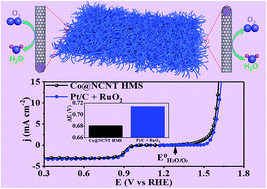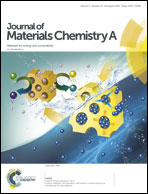Hierarchical 3D macrosheets composed of interconnected in situ cobalt catalyzed nitrogen doped carbon nanotubes as superior bifunctional oxygen electrocatalysts for rechargeable Zn–air batteries†
Abstract
The oxygen reduction/evolution reactions (ORR/OER) are the cornerstone of metal–air batteries. The current central issue is to explore nonprecious metal based catalysts, especially bifunctional electrocatalysts with high activity for both ORR/OER processes with mild strategies. Herein, we report a facile yet scalable approach to fabricate hierarchical 3D macrosheets composed of interconnected in situ cobalt catalyzed nitrogen doped carbon nanotubes (denoted as Co@NCNT HMS) through the pyrolysis of g-C3N4@Co-glycolate microsheets, which exhibit outstanding oxygen catalysis performance. Specifically, a record low potential gap (ΔE = Ej10 − E1/2) of 0.681 V can be achieved in 1 M KOH electrolyte. Impressively, a Zn–air battery based on a Co@NCNT HMS air cathode achieves a specific capacity of 675.8 mA h g−1 and a peak power density of 159.83 mW cm−2. More importantly, the cycling stability of the rechargeable Zn–air battery is outstanding with an excellent output voltage retention (97.3% after 150 h).



 Please wait while we load your content...
Please wait while we load your content...